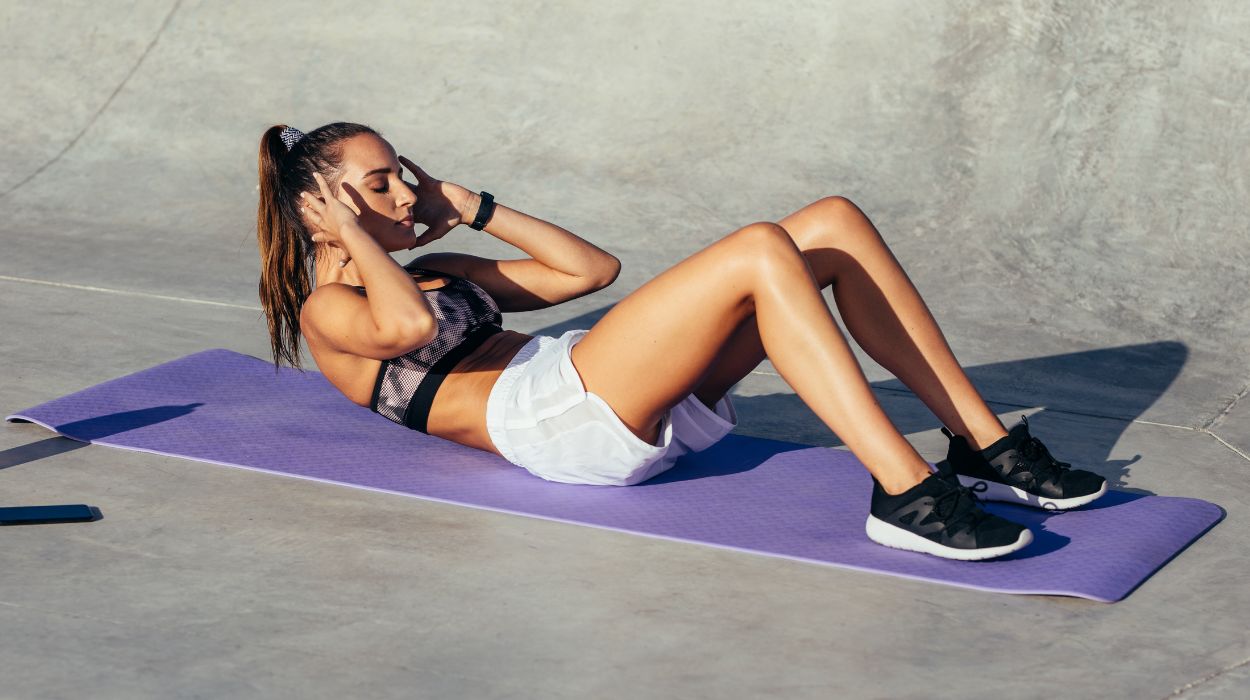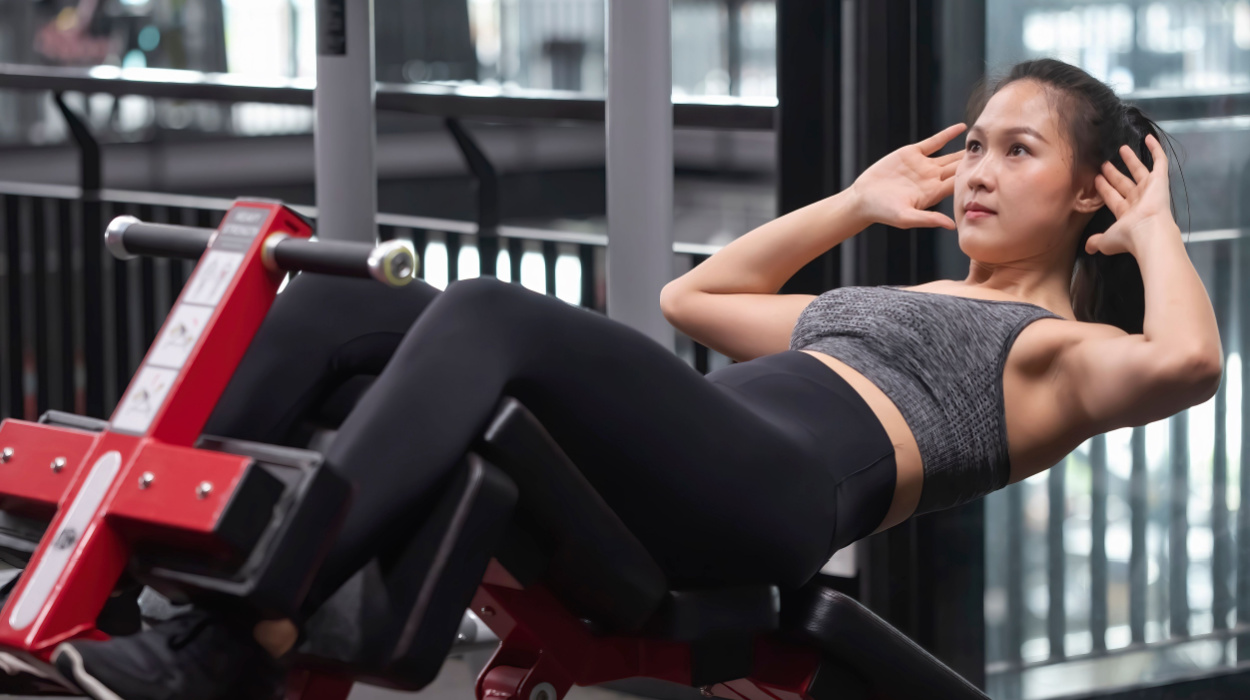Burning belly fat is a common fitness goal for many, and sit-ups are a valuable exercise for strengthening the core. But many question whether sit-ups actually help you lose belly fat. If so, the next question is, “How many sit-ups a day to lose belly fat?”
The number will vary based on various factors. Let’s explore the role sit-ups play in weight loss. We’ll cover the mechanics of how to do sit-ups effectively to ensure you maximize their potential to help lose fat. Understanding proper form is crucial to avoiding injury and targeting your abdominal muscles effectively.
We’ll also dive into the numerous benefits of incorporating sit-ups into your fitness routine. From toning your core to improving posture, these exercises offer many benefits when done safely and consistently.
Learn how daily sit-ups can improve your results and help you achieve your fitness goals.
How Many Sit-Ups Should You Do A Day To Lose Belly Fat?
Sit-ups aren’t directly effective in reducing belly fat, as spot reduction is not possible. However, sit-ups can support weight loss efforts through their role in developing lean muscle mass. Sit-ups can also improve posture, reduce back pain, and strengthen core muscles.
Adding sit-ups to your exercise routine can help you achieve a slimmer appearance by enhancing muscle definition. While the recommended number may vary between individuals, 8-12 repetitions for three sets, three times weekly is a good place to start. You’ll notice a reduction in body weight when you eat a healthy diet and add sit-ups to an exercise regimen.
How Many Sit-Ups A Day Help Shed Stomach Fat?
Although sit-ups are often considered a go-to exercise for shedding stomach fat, they are not a direct fat-loss solution. However, they can help you achieve a slimmer appearance when added to a daily exercise routine and healthy eating.
So, you may wonder, “How many sit-ups I should do a day?” The key to any results lies in consistency. The American College of Sports Medicine recommends[1] 8-12 repetitions per set for three sets, three times weekly.
As your core strength improves, you can gradually increase[2] the number of sit-ups you do or add weight to increase results. However, it’s important to note that too many sit-ups in one session can strain the neck and lower back and lead to abdominal trauma.
Additionally, if you can do excessive sit-ups without strain or exhaustion, you may be doing them wrong. Stick with the recommended repetitions and ensure you perform each sit-up while focusing on the ab muscles you intend to target.
Do Sit-Ups Burn Belly Fat?

No, sit-ups do not directly burn abdominal fat. However, they primarily target the muscles in your core, helping to strengthen and tone the muscles. Plus, research has shown[3] that increased muscle mass can boost metabolism, as muscle burns more calories than fat.
They can also improve posture[4] and muscle definition to give you the appearance of weight loss and reduce the risk of injury.[5] Still, fat loss occurs through a calorie deficit, achieved by burning more calories than you consume. For the best results to lose belly fat, it’s crucial to integrate sit-ups into a regular workout routine and pair this[6] with a well-balanced diet plan.
Dietary choices play a significant role in shedding excess body fat. Prioritizing complex carbohydrates and increasing your protein[7] and fiber intake can support lean muscle mass, reducing belly fat. You should also limit added sugars and processed foods.
Adding moderate to vigorous exercise[8] also helps target visceral fat. You should also aim for 150 minutes of moderate-intensity physical activity[9] weekly, with two days of strength training. Running, playing sports, jump roping, power-walking, and other similar cardiovascular exercises can be incredibly helpful in shedding excess abdominal fat.
You won’t lose weight overnight with any strategy, but you can achieve noticeable results with consistent effort, proper nutrition, and healthy lifestyle changes.
How To Do Sit-Ups
Performing sit-ups with the proper technique is crucial to prevent injury and achieve the desired results. Effective sit-ups require the following steps for the best results:
- Place your body flat on a mat with your knees gently flexed.
- Position your toes beneath a ledge or a set of dumbbells.
- Keep your hands beside your temples throughout the exercise and avoid grasping the back of your neck.
- Engage your core muscles and exhale as you lift your upper body towards your thighs in a curling motion.
- Ensure you emphasize using your abdominal muscles and hips to raise your body weight.
- Inhale as you gently lower yourself to return to the initial position.
You can implement several different core exercises to help you reach your weight loss goals and strengthen your core. A certified personal trainer can help you decide what abdominal exercises to incorporate into your workouts.
Planks
Planks are crucial for developing and enhancing the abdominal and oblique muscles. They also go beyond the core, working multiple muscle groups, including the arms, shoulders, legs, and back.
- Assume a tabletop position on a mat.
- Place both hands on the ground, directly aligned under your shoulders.
- Step back with both feet and ensure they are at hip-width distance. The position should mimic the initial stage of a push-up.
- Maintain this posture with the lower back in straight alignment with your entire body.
- Keep your core engaged continuously.
- Set a timer to gauge how long you can hold the position.
Bicycle Crunches
Bicycle crunches effectively engage both lower and upper abdominal muscles when performed with controlled movement and coordinated deep breathing. They effectively target all four abdominal muscle groups. Additionally, the alternating movements help maintain an elevated heart rate, which is vital for calorie expenditure.
- Begin by lying flat on a mat. Your upper body should be in contact with the mat’s surface and your feet should be firmly planted on the ground with knees slightly bent.
- Place your hands gently beside your temples.
- Engage your core by contracting your abdominal muscles and pulling in your belly button.
- Elevate your upper body off the mat, retract your shoulders, and initiate a pedaling motion with your left leg.
- Draw your left knee toward your chest while extending your right leg outward.
- Simultaneously, rotate your torso, bringing your right elbow toward your left knee.
- Mirror this movement on the opposite side and continue alternating to complete a set.
Burpees
Burpees are effective for fat-burning and developing core muscles. They are a full-body workout with a high-intensity nature.
- Begin by standing with a mat in front of you.
- Bend your knees, push back with your hips, and lower yourself to the floor.
- Jump back, placing both hands on the mat to assume a high plank position.
- Engage your core muscles to jump forward, landing on both feet near your upper body.
- Explosively jump vertically with your arms raised above your head, driving from your heels.
Russian Twists
Russian twists are highly effective abdominal exercises that can help you strengthen and tone your abdominal muscles. This versatile exercise engages various muscle groups in the core and obliques while improving balance and stability.
- Sit on the floor with your knees bent and your feet flat, keeping your back straight.
- Lean back slightly, creating a V-shape with your upper body and thighs.
- Keep your heels lightly touching the ground for balance.
- Clasp your hands together in front of your chest to maintain a neutral posture.
- Lift your feet slightly off the ground to balance on your tailbone.
- Twist your torso to one side, bringing your clasped hands beside your hip.
- Exhale as you twist and engage your core muscles.
- Inhale as you return to the starting position, keep your feet off the ground, and twist in the opposite direction.
- Repeat the twisting motion from side to side for the desired number of repetitions.
Leg Raises
Leg raises effectively target and strengthen your lower abdominal muscles, contributing to a well-rounded core workout routine.
- On a mat, lie flat on your back with your legs extended and your arms resting by your sides.
- Ensure your lower back is pressed into the floor to maintain proper spinal alignment.
- Place your hands under or beside your hips for added stability.
- Tighten your abdominal muscles by drawing your navel towards your spine. This helps protect your lower back during the exercise.
- While keeping your legs straight, slowly raise them off the ground. Exhale as you lift your legs and raise them as high as possible while maintaining control.
- Pause briefly at the top of the movement to feel the tension in your lower abdominal muscles.
- Slowly lower your legs, ensuring they don’t touch the floor. Inhale as you lower your legs.
- Start with a manageable number of repetitions and gradually increase as your core strength improves.
Mountain Climbers
Mountain climbers are dynamic core strengthening exercises that provide a powerful workout for the targeted muscle group. Their combination of cardiovascular exercise intensity and core engagement makes them excellent for strengthening and toning your body.
- Begin in a push-up position with your hands directly under your shoulders and your body forming a straight line from head to heels.
- Tighten your core muscles to stabilize your spine and maintain proper body alignment.
- Bring one knee towards your chest while extending the other leg.
- Alternate between your right and left knees as if running in place.
- Move your legs with a quick and controlled motion, ensuring your knees come close to your chest with each step.
- Maintain a steady pace to increase the intensity.
- Aim for a specific duration or a set number of repetitions.
Benefits Of Doing Sit-Ups
There are several advantages of incorporating core exercises into your fitness routine, including the following:
- Strengthen core muscles: Regular sit-ups engage the rectus abdominis,[10] transverse abdominis, and obliques. This provides support and stability to your spine. They also activate the hip flexors, lower back, and chest.
- Improve posture: Sit-ups promote better posture by improving your core strength. Improved spinal stability[4] can prevent injuries and promote long-term musculoskeletal health. It can also reduce your risk of discomfort related to poor spinal alignment.
- Reduce back pain: Regular abdominal exercises help reduce lower back pain by increasing core stability. This is a significant benefit because studies show[11] that 60-80% of adults in Western countries experience lower back pain.
- Enhance fitness and athletic performance: Strengthening the core and enhancing your overall body strength can improve athletic and fitness performance.
- Improve balance: Core exercises require balance and coordination as you control your body’s movement. This contributes to improved stability[4] and overall balance.
- Enhance abdominal muscle definition: Consistent sit-ups contribute to more defined and toned abs. This can help you reach the coveted sculpted and flat stomach many strive to achieve.
- Support other compound exercises: A strong core is essential for many compound movements in sports and fitness. Therefore, sit-ups are a valuable foundation for more advanced exercises and functional fitness activities.
- Minimal to no equipment needed: Sit-ups can be performed virtually anywhere because they require minimal or no equipment. They are also accessible to people at varying fitness levels.
- Versatile and easy to incorporate into your fitness routine: Sit-ups are versatile as a standalone exercise or part of a broader exercise program. You can easily adapt them to your fitness goals and preferences.
Cautions While Doing Sit-Ups

Before starting your sit-up routine, it’s essential to be mindful of safety cautions to avoid injury. Here are some tips to help you perform sit-ups effectively and make the most of your core exercises:
- Protect your neck: Avoid pulling on your neck or placing undue strain on it during sit-ups, as neck discomfort and injury are common.
- Engage your core: Before you begin any core movements, engage your abdominal muscles. This will ensure you are using the right muscles to improve core strength.
- Don’t round your spine: Keep your back straight and maintain a neutral spine. Make sure your neck and arms aren’t doing the work. This will prevent lower back pain[10] and injury.
- Focus on your breath: Remember to breathe consistently. Gently exhale as you engage your abdominal muscles. Inhale as you slowly lower yourself to your starting position. Proper breathing is essential, as holding your breath can increase the risk of dizziness and fainting.
- Avoid overtraining: Don’t overdo it. Overtraining your core can lead to muscle fatigue and potential injury.
- Consult a professional: Consult a fitness professional or healthcare provider before beginning an intense sit-up routine. While this is most helpful for beginners, it’s also crucial to consult a professional if you have underlying health conditions or concerns.
Conclusion
Sit-ups contribute to weight loss indirectly by strengthening your core and giving your abdomen a more toned appearance. The number of recommended daily sit-ups will vary based on your age, fitness history, weight goals, and other factors. However, the general recommendation is 8-12 repetitions for three sets, three days per week.
You can incorporate various core exercises into your weekly routine for overall fitness, improved posture, and enhanced core strength. Pairing these movements with a balanced diet and aerobic exercises is essential for the most effective weight loss results.
Frequently Asked Questions
Doing sit-ups daily won’t directly lead to losing abdominal fat, but it can help tone and strengthen your core. You may notice a slimmer appearance by building muscle mass and posture. Fat loss requires consistent exercise and a balanced diet.
The answer varies from one individual to the next, depending on your current fitness level and goals. A combination of regular core exercises, cardiovascular workouts, and a balanced diet is the best strategy for weight loss.
Performing 100 sit-ups daily can help build core strength and muscle endurance, but it isn’t a direct fat-burning solution. Overtraining may lead to muscle fatigue and potential injury. A balanced routine is key based on your current fitness level.
Consistently doing 20 sit-ups a day can strengthen your core muscles and improve posture but doesn’t significantly impact fat loss. A comprehensive fitness routine and dietary adjustments are necessary for such.
While sit-ups can help tone your abdominal muscles and improve posture, they alone won’t flatten your stomach. Fat loss requires a combination of exercise, diet, and overall fitness targeted to each individual specifically.
Sit-ups won’t directly reduce abdominal fat, but they strengthen core muscles and improve muscle definition. A stronger core can contribute to a slimmer, more toned appearance that enhances overall strength and appears like you’ve lost weight in your midsection.
Sit-ups are not particularly effective for addressing water weight. Reducing water retention involves maintaining proper hydration, balanced sodium intake, and overall lifestyle adjustments rather than specific exercises.
 Evidence Based
Evidence Based
